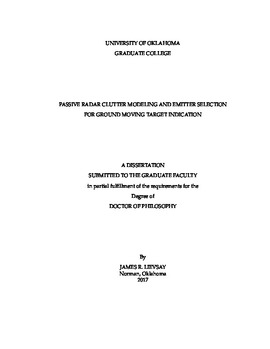| dc.description.abstract | Moving target detection with a passive radar system relies on many competing and coupled variables. When simulating a passive bistatic radar (PBR) system for ground moving target indication (GMTI) a three-dimensional model is critical. The signal path geometry induced from separating the radar receiver and transmitter causes several performance effects that change with location.
Since a performance prediction is only as good as the model, the choice of how to model clutter becomes important. Measured data of bistatic clutter shows that the received clutter power depends on scattering angles. Therefore, a new in-plane out-of-plane (IPOP) interpolation model was developed. The IPOP model causes high clutter returns to reside in regions near an in-plane orientation (forward or backward scattering). The model produces a more localized clutter spectrum in angle-Doppler space when compared to monostatic radar.
Generally, the stationary transmitter is modeled as a communication emitter due to the availability. These continuous waveforms must be partitioned as pulses spaced at constant intervals over the coherent processing interval (CPI). This diverse pulse train is non-ideal for pulse-Doppler radars. The waveform produces high range sidelobes and causes colored noise to spread in Doppler. It is shown for the first time that these waveform effects can be modeled through a covariance matrix taper (CMT).
Choosing an optimal emitter becomes an interesting problem when multiple emitters are present. A common metric for GMTI when using space-time adaptive processing (STAP) is signal-to-interference-plus-noise ratio (SINR). However, SINR changes based off relative geometries, and GMTI depends on where a target's location and two-dimensional velocity maps into angle-Doppler space. Therefore, average SINR, weighted average SINR, minimum SINR, and usable velocity space fraction (UVSF) are the newly developed metrics proposed for down-selecting to an optimal emitter. The choice of metric is extremely dependent on the scenario.
Finally, in STAP large clutter discretes (LCDs) can cause either false alarms or missed detections. Ultimately, they contaminate the data, and it is very desirable, yet very hard, to remove LCDs. However, the clutter structure in angle-Doppler space for PBR can offer a benefit for removing an LCD. Due to the fact that bistatic clutter can be more localized in angle-Doppler, the detection and estimation of an LCD can be accomplished for an out-of-plane geometry. Then the LCD can be successfully removed from the data, and new application of spectral estimation techniques have been developed for this purpose. | en_US |
